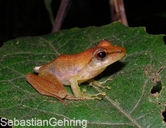|
Description
M 47-53 mm, F 48 mm. One of the largest species in the subgenus Duboimantis. Distinguishable by the distinct but weakly expressed interocular tubercles, absence of other tubercles and ridges, distinct and large femoral glands, and relatively short hindlimbs, the tibiotarsal articulation not reaching beyond snout tip, often reaching only the eye or nostril.
Similar species: G. cornutus has longer hind legs (tibiotarsal articulation reaches beyond tip of snout), conspicuous black tubercles between the eyes, smaller femoral glands and a smaller body size. In G. granulatus, the tibiotarsal articulation reaches beyond tip of snout, vocal sacs are paired and the two black tubercles between the eyes are not present. Distribution and Habitat
Country distribution from AmphibiaWeb's database: Madagascar
Ambanizana, Ambatovaky, Ambohitsara, Ambolokopatrika corridor, An’Ala, Anjanaharibe, Besariaka, Brickaville, forest near Andranofotsy, Mananara, Mangevo (Ranomafana), Marojejy, Nosy Boraha, Nosy Mangabe, Sahembendrana, Vohidrazana (Glaw and Vences 2007).
This species is found both on the ground and in trees, usually near streams in pristine rainforest and is not found in altered habitats. It has been observed from sea level up to 850m (Glaw and Raxworthy 2008).
Life History, Abundance, Activity, and Special Behaviors
Habits: Males call at dusk and night from perches 1-2 m above the ground in vegetation along streams in rainforest.
Calls: Very characteristic guttural unharmonious notes. Often only single notes are emitted after regular intervals, sometimes notes are arranged in series.
Eggs and tadpoles: Unknown, probably not direct development.
Trends and Threats
This species is listed as least concern in view of its wide distribution, presumed large population, and because it is unlikely to be declining fast enough to qualify for listing in a more threatened category. However, its forest habitat is receding due to subsistence agriculture, timber extraction, charcoal manufacture, and invasive spread of eucalyptus, livestock grazing and expanding human settlements. There is probably little habitat left in the southern part of its range (Glaw and Raxworthy 2008). Possible reasons for amphibian decline General habitat alteration and loss
Habitat modification from deforestation, or logging related activities
Intensified agriculture or grazing
Urbanization
Subtle changes to necessary specialized habitat
Comments
Taken with permission from Glaw and Vences (2007).
References
Glaw, F. and Raxworthy, C. (2008). Gephyromantis redimitus. In: IUCN 2008. 2008 IUCN Red List of Threatened Species. www.iucnredlist.org. Downloaded on 18 March 2009.
Glaw, F., and Vences, M. (2007). Field Guide to the Amphibians and Reptiles of Madagascar. Third Edition. Vences and Glaw Verlag, Köln.
Originally submitted by: Miguel Vences and Frank Glaw (first posted 2000-11-30)
Edited by: Catherine Aguilar (2009-04-07)Species Account Citation: AmphibiaWeb 2009 Gephyromantis redimitus <https://amphibiaweb.org/species/4623> University of California, Berkeley, CA, USA. Accessed Jun 17, 2025.
Feedback or comments about this page.
Citation: AmphibiaWeb. 2025. <https://amphibiaweb.org> University of California, Berkeley, CA, USA. Accessed 17 Jun 2025.
AmphibiaWeb's policy on data use.
|
